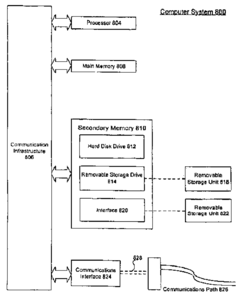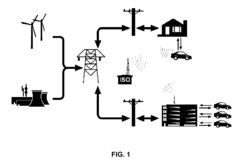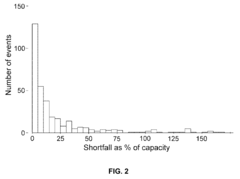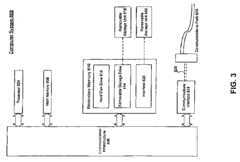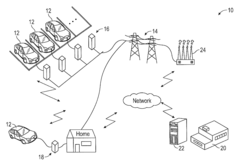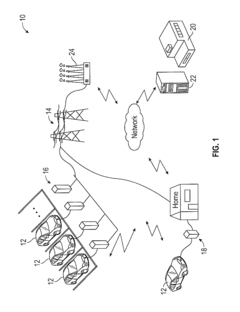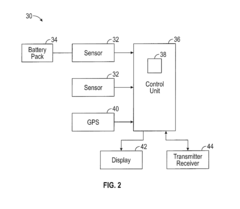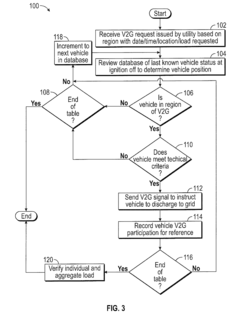Assessing the Lifecycle Impacts of Vehicle-to-Grid Batteries
SEP 23, 20259 MIN READ
Generate Your Research Report Instantly with AI Agent
Patsnap Eureka helps you evaluate technical feasibility & market potential.
V2G Battery Technology Background and Objectives
Vehicle-to-Grid (V2G) technology represents a transformative approach to energy management that has evolved significantly over the past decade. The concept emerged in the late 1990s but gained substantial momentum after 2010 as electric vehicle (EV) adoption increased and smart grid technologies matured. V2G enables bidirectional power flow between electric vehicles and the electricity grid, allowing EVs to not only consume energy but also return it to the grid during peak demand periods or grid instability events.
The evolution of V2G technology has been closely tied to advancements in battery technology, power electronics, and grid management systems. Early implementations faced significant challenges related to battery degradation, communication protocols, and regulatory frameworks. However, recent technological breakthroughs in battery chemistry, particularly with lithium-ion variants optimized for cycling, have addressed many of these initial concerns.
Current V2G systems typically operate through specialized bidirectional chargers that enable controlled energy exchange between vehicles and the grid. These systems incorporate sophisticated battery management systems (BMS) that monitor state-of-charge, temperature, and other critical parameters to ensure safe and efficient operation while minimizing battery degradation.
The primary technical objectives for V2G battery technology development include extending battery cycle life under bidirectional power flow conditions, reducing efficiency losses during energy conversion, developing standardized communication protocols, and creating predictive algorithms for optimal battery utilization. Additionally, there is significant focus on understanding and mitigating the accelerated aging effects that may result from the additional cycling demands placed on batteries in V2G applications.
From an environmental perspective, V2G technology aims to reduce greenhouse gas emissions by facilitating greater integration of renewable energy sources into the grid. By providing flexible storage capacity, V2G-enabled vehicles can help balance supply and demand fluctuations inherent to renewable generation, potentially reducing the need for fossil fuel-based peaker plants.
Economic objectives include creating viable business models for V2G participation, quantifying the value of grid services provided by EVs, and developing compensation mechanisms for EV owners. The technology also seeks to reduce overall electricity system costs by leveraging existing battery assets rather than building dedicated stationary storage.
The lifecycle assessment of V2G batteries must consider multiple factors beyond traditional EV battery evaluations, including additional cycling, varied depth-of-discharge patterns, and potential second-life applications. This comprehensive evaluation is essential for accurately determining the environmental and economic viability of widespread V2G implementation.
The evolution of V2G technology has been closely tied to advancements in battery technology, power electronics, and grid management systems. Early implementations faced significant challenges related to battery degradation, communication protocols, and regulatory frameworks. However, recent technological breakthroughs in battery chemistry, particularly with lithium-ion variants optimized for cycling, have addressed many of these initial concerns.
Current V2G systems typically operate through specialized bidirectional chargers that enable controlled energy exchange between vehicles and the grid. These systems incorporate sophisticated battery management systems (BMS) that monitor state-of-charge, temperature, and other critical parameters to ensure safe and efficient operation while minimizing battery degradation.
The primary technical objectives for V2G battery technology development include extending battery cycle life under bidirectional power flow conditions, reducing efficiency losses during energy conversion, developing standardized communication protocols, and creating predictive algorithms for optimal battery utilization. Additionally, there is significant focus on understanding and mitigating the accelerated aging effects that may result from the additional cycling demands placed on batteries in V2G applications.
From an environmental perspective, V2G technology aims to reduce greenhouse gas emissions by facilitating greater integration of renewable energy sources into the grid. By providing flexible storage capacity, V2G-enabled vehicles can help balance supply and demand fluctuations inherent to renewable generation, potentially reducing the need for fossil fuel-based peaker plants.
Economic objectives include creating viable business models for V2G participation, quantifying the value of grid services provided by EVs, and developing compensation mechanisms for EV owners. The technology also seeks to reduce overall electricity system costs by leveraging existing battery assets rather than building dedicated stationary storage.
The lifecycle assessment of V2G batteries must consider multiple factors beyond traditional EV battery evaluations, including additional cycling, varied depth-of-discharge patterns, and potential second-life applications. This comprehensive evaluation is essential for accurately determining the environmental and economic viability of widespread V2G implementation.
Market Demand Analysis for V2G Integration
The Vehicle-to-Grid (V2G) technology market is experiencing significant growth driven by the convergence of renewable energy integration, grid stability concerns, and electric vehicle proliferation. Current market analysis indicates that the global V2G market is projected to grow at a compound annual growth rate of 48% between 2023 and 2030, reaching approximately 17.4 billion USD by 2030. This exceptional growth trajectory is supported by increasing governmental policies promoting clean energy and sustainable transportation systems worldwide.
Consumer demand for V2G integration is primarily concentrated in regions with high electric vehicle adoption rates and progressive energy policies, notably Western Europe, North America, and parts of East Asia. The Netherlands, Denmark, and the United Kingdom lead European markets, while California dominates the North American landscape. Japan and South Korea represent significant Asian market opportunities due to their advanced grid infrastructure and energy security concerns.
Utility companies represent a critical demand segment, increasingly viewing V2G as a valuable tool for grid management and peak load reduction. Recent surveys indicate that 78% of utility executives consider V2G integration as "important" or "very important" for future grid stability. This perspective is driving substantial investments in pilot programs and infrastructure development across major markets.
Commercial fleet operators constitute another significant market segment, motivated by potential revenue streams from grid services and reduced total cost of ownership. Fleet electrification initiatives by companies like Amazon, UPS, and FedEx are creating substantial opportunities for V2G implementation at scale. The commercial sector is projected to account for 62% of V2G market value through 2028.
Residential consumers represent an emerging but potentially massive market segment. While currently limited by infrastructure constraints and awareness issues, this segment shows promising growth potential as simplified V2G solutions and attractive pricing models emerge. Consumer surveys indicate that 43% of EV owners would consider V2G participation if financial incentives exceeded 500 USD annually.
Market barriers include regulatory uncertainties, battery degradation concerns, and infrastructure limitations. The regulatory landscape remains fragmented, with varying compensation mechanisms and interconnection standards across regions. Technical standardization efforts are progressing through organizations like ISO, IEC, and SAE, but global harmonization remains incomplete.
The V2G market is increasingly characterized by strategic partnerships between automotive manufacturers, charging infrastructure providers, and energy management companies. These collaborations aim to create integrated ecosystems that maximize value extraction from bidirectional energy flows while minimizing implementation complexity for end users.
Consumer demand for V2G integration is primarily concentrated in regions with high electric vehicle adoption rates and progressive energy policies, notably Western Europe, North America, and parts of East Asia. The Netherlands, Denmark, and the United Kingdom lead European markets, while California dominates the North American landscape. Japan and South Korea represent significant Asian market opportunities due to their advanced grid infrastructure and energy security concerns.
Utility companies represent a critical demand segment, increasingly viewing V2G as a valuable tool for grid management and peak load reduction. Recent surveys indicate that 78% of utility executives consider V2G integration as "important" or "very important" for future grid stability. This perspective is driving substantial investments in pilot programs and infrastructure development across major markets.
Commercial fleet operators constitute another significant market segment, motivated by potential revenue streams from grid services and reduced total cost of ownership. Fleet electrification initiatives by companies like Amazon, UPS, and FedEx are creating substantial opportunities for V2G implementation at scale. The commercial sector is projected to account for 62% of V2G market value through 2028.
Residential consumers represent an emerging but potentially massive market segment. While currently limited by infrastructure constraints and awareness issues, this segment shows promising growth potential as simplified V2G solutions and attractive pricing models emerge. Consumer surveys indicate that 43% of EV owners would consider V2G participation if financial incentives exceeded 500 USD annually.
Market barriers include regulatory uncertainties, battery degradation concerns, and infrastructure limitations. The regulatory landscape remains fragmented, with varying compensation mechanisms and interconnection standards across regions. Technical standardization efforts are progressing through organizations like ISO, IEC, and SAE, but global harmonization remains incomplete.
The V2G market is increasingly characterized by strategic partnerships between automotive manufacturers, charging infrastructure providers, and energy management companies. These collaborations aim to create integrated ecosystems that maximize value extraction from bidirectional energy flows while minimizing implementation complexity for end users.
Current V2G Battery Challenges and Limitations
Vehicle-to-Grid (V2G) battery technology faces several significant challenges that currently limit its widespread adoption and effectiveness. Battery degradation remains a primary concern, as the additional cycling from grid services accelerates capacity fade and reduces overall battery lifespan. Studies indicate that frequent bidirectional charging can increase degradation rates by 10-20% compared to standard EV usage patterns, potentially shortening battery life by 1-3 years depending on usage intensity.
Technical integration challenges persist across the V2G ecosystem. Current battery management systems (BMS) are not optimized for bidirectional power flow, creating difficulties in accurately monitoring state of charge and health during V2G operations. The lack of standardized communication protocols between vehicles, charging infrastructure, and grid operators further complicates seamless integration, with competing standards like CHAdeMO, CCS, and proprietary systems creating market fragmentation.
Economic barriers represent another significant limitation. The high initial cost of bidirectional charging equipment—typically 2-3 times more expensive than standard chargers—creates substantial entry barriers. Current compensation models for grid services often fail to adequately offset the accelerated battery degradation costs, resulting in uncertain return on investment for vehicle owners and fleet operators.
Regulatory frameworks remain underdeveloped in most markets, creating uncertainty around participation requirements, liability issues, and compensation structures. Many jurisdictions lack clear policies regarding energy prosumers, creating ambiguity about how V2G participants should be classified and compensated within existing market structures.
Technical performance limitations also impact V2G viability. Response times for grid services vary significantly between different battery chemistries and management systems, with some configurations unable to meet the millisecond-level response requirements for certain grid services like frequency regulation. Power conversion efficiency losses during bidirectional charging (typically 10-15%) reduce the overall energy efficiency of V2G systems compared to traditional grid storage solutions.
User experience concerns further complicate adoption. Range anxiety is amplified when battery capacity is committed to grid services, and current user interfaces often fail to provide transparent information about energy commitments, financial compensation, and impacts on vehicle availability. The complexity of participation requirements and scheduling creates friction that discourages consumer engagement with V2G programs.
These multifaceted challenges necessitate coordinated technological development, regulatory innovation, and business model evolution to unlock the full potential of V2G battery systems in supporting grid stability while maintaining acceptable vehicle performance and battery longevity.
Technical integration challenges persist across the V2G ecosystem. Current battery management systems (BMS) are not optimized for bidirectional power flow, creating difficulties in accurately monitoring state of charge and health during V2G operations. The lack of standardized communication protocols between vehicles, charging infrastructure, and grid operators further complicates seamless integration, with competing standards like CHAdeMO, CCS, and proprietary systems creating market fragmentation.
Economic barriers represent another significant limitation. The high initial cost of bidirectional charging equipment—typically 2-3 times more expensive than standard chargers—creates substantial entry barriers. Current compensation models for grid services often fail to adequately offset the accelerated battery degradation costs, resulting in uncertain return on investment for vehicle owners and fleet operators.
Regulatory frameworks remain underdeveloped in most markets, creating uncertainty around participation requirements, liability issues, and compensation structures. Many jurisdictions lack clear policies regarding energy prosumers, creating ambiguity about how V2G participants should be classified and compensated within existing market structures.
Technical performance limitations also impact V2G viability. Response times for grid services vary significantly between different battery chemistries and management systems, with some configurations unable to meet the millisecond-level response requirements for certain grid services like frequency regulation. Power conversion efficiency losses during bidirectional charging (typically 10-15%) reduce the overall energy efficiency of V2G systems compared to traditional grid storage solutions.
User experience concerns further complicate adoption. Range anxiety is amplified when battery capacity is committed to grid services, and current user interfaces often fail to provide transparent information about energy commitments, financial compensation, and impacts on vehicle availability. The complexity of participation requirements and scheduling creates friction that discourages consumer engagement with V2G programs.
These multifaceted challenges necessitate coordinated technological development, regulatory innovation, and business model evolution to unlock the full potential of V2G battery systems in supporting grid stability while maintaining acceptable vehicle performance and battery longevity.
Current V2G Battery Lifecycle Management Solutions
01 Battery lifecycle management and environmental impact assessment
Systems and methods for managing the lifecycle of vehicle-to-grid batteries, including monitoring environmental impacts throughout their use. These technologies track battery performance degradation over time, assess carbon footprint, and evaluate the overall environmental sustainability of battery usage in V2G applications. The solutions include tools for lifecycle assessment that consider manufacturing, usage, and end-of-life disposal phases to optimize battery utilization while minimizing ecological impact.- Battery lifecycle management and environmental impact assessment: This category focuses on the environmental impacts of vehicle-to-grid (V2G) battery systems throughout their lifecycle. It includes methodologies for assessing carbon footprints, energy consumption during manufacturing, use, and disposal phases. These technologies help quantify and minimize the ecological footprint of V2G systems by tracking resource utilization, emissions, and waste generation, ultimately supporting more sustainable battery deployment in grid integration applications.
- Battery degradation monitoring and performance optimization in V2G systems: These innovations address the monitoring and management of battery degradation in V2G applications. They include systems for tracking battery health parameters, predicting remaining useful life, and optimizing charging/discharging cycles to minimize degradation. Advanced algorithms analyze usage patterns to balance grid service provision with battery longevity, helping to extend operational lifespans and improve the economic viability of V2G battery systems through strategic management of cycling patterns.
- Second-life applications and recycling of V2G batteries: This category encompasses technologies for repurposing and recycling V2G batteries after their primary automotive use. It includes methods for assessing residual capacity, refurbishing battery packs, and integrating them into stationary storage applications. These innovations extend the useful life of batteries beyond vehicle applications, creating circular economy opportunities and reducing waste. The technologies also cover efficient recycling processes to recover valuable materials from batteries that can no longer serve in any capacity.
- V2G integration and grid impact management: These technologies focus on the integration of V2G systems with power grids and the management of their impacts on grid infrastructure. They include smart charging strategies, load balancing techniques, and grid stability enhancement methods. The innovations address challenges such as peak demand management, frequency regulation, and voltage support through coordinated control of distributed vehicle batteries. These systems help maximize the grid services provided by V2G while minimizing negative impacts on infrastructure and ensuring reliable operation.
- Economic and data-driven lifecycle assessment tools: This category covers economic modeling and data analytics tools for comprehensive lifecycle assessment of V2G battery systems. These innovations include cost-benefit analysis frameworks, predictive maintenance algorithms, and decision support systems that incorporate both financial and environmental factors. They enable stakeholders to evaluate the total cost of ownership, return on investment, and sustainability metrics throughout the battery lifecycle, supporting informed decision-making for V2G deployment and operation.
02 Battery second-life applications and repurposing
Innovations focused on extending the useful life of vehicle batteries through second-life applications after they no longer meet the requirements for vehicle use. These technologies include methods for assessing remaining battery capacity, repurposing batteries for stationary grid storage, and developing systems that facilitate the transition from vehicle to grid applications. The solutions aim to maximize the economic and environmental value of batteries by enabling their continued use in less demanding grid support roles.Expand Specific Solutions03 V2G battery performance monitoring and grid integration
Technologies for real-time monitoring and management of vehicle-to-grid battery performance during grid integration. These systems track battery health, state of charge, and operational parameters while connected to the electrical grid. The innovations include communication protocols between vehicles and grid operators, algorithms for optimizing power flow, and methods for predicting battery degradation based on V2G usage patterns to ensure efficient and sustainable grid participation.Expand Specific Solutions04 Economic and carbon impact analysis of V2G systems
Methods and systems for analyzing the economic viability and carbon impact of vehicle-to-grid implementations. These technologies evaluate the cost-benefit ratio of V2G participation, including battery degradation costs, energy market participation revenue, and carbon emission reductions. The solutions incorporate predictive modeling to assess long-term financial returns and environmental benefits, helping stakeholders make informed decisions about V2G adoption and implementation strategies.Expand Specific Solutions05 Battery recycling and material recovery technologies
Innovations focused on end-of-life management for vehicle-to-grid batteries, including recycling processes and material recovery technologies. These solutions address the challenges of safely dismantling batteries, extracting valuable materials like lithium, cobalt, and nickel, and minimizing waste. The technologies include automated sorting systems, hydrometallurgical and pyrometallurgical recovery processes, and methods for assessing the environmental impact of different recycling approaches to create more sustainable battery lifecycle management.Expand Specific Solutions
Key Industry Players in V2G Battery Ecosystem
The Vehicle-to-Grid (V2G) battery technology market is currently in its early growth phase, characterized by increasing research activities and pilot deployments. The global V2G market is projected to expand significantly, driven by the rising adoption of electric vehicles and renewable energy integration needs. From a technical maturity perspective, established automotive manufacturers like GM, Volkswagen, Ford, and Hyundai-Kia are making substantial investments in V2G capabilities, while battery specialists such as LG Energy Solution, Panasonic, and GS Yuasa are developing optimized battery systems. Technology companies like PMGROW and Hitachi are focusing on the software and grid integration aspects. The competitive landscape shows a mix of traditional automakers pivoting toward electrification and specialized battery manufacturers working to address lifecycle impact challenges through improved battery chemistry and smart management systems.
LG Energy Solution Ltd.
Technical Solution: LG Energy Solution has developed the "V2G Lifecycle Optimization Platform" specifically addressing battery longevity in bidirectional power applications. Their technology incorporates advanced lithium-ion cell designs with modified electrode materials and electrolyte formulations that demonstrate enhanced cycle life under the irregular charge-discharge patterns characteristic of V2G operations. LG's system employs machine learning algorithms that continuously analyze battery performance data, grid conditions, and vehicle usage patterns to optimize V2G participation schedules that minimize degradation. Their comprehensive lifecycle assessment framework quantifies environmental impacts from raw material extraction through manufacturing, use phase benefits from grid services, and end-of-life management. Laboratory testing shows their V2G-optimized cells maintain 85% capacity after 3,000 equivalent full cycles with bidirectional power flow, representing approximately 30% improvement over conventional EV batteries. LG has also implemented a battery passport system that tracks the complete history of V2G participation, enabling more accurate second-life valuation and appropriate recycling pathways.
Strengths: Cell-level chemistry optimizations specifically for V2G applications; comprehensive data tracking enables accurate lifecycle impact assessment. Weaknesses: Premium battery formulations increase initial manufacturing costs; system requires sophisticated integration with vehicle battery management systems across multiple OEMs.
General Motors LLC
Technical Solution: General Motors has developed an advanced Vehicle-to-Grid (V2G) battery management system that optimizes battery lifecycle while enabling bidirectional power flow. Their technology incorporates predictive analytics to monitor battery degradation factors during V2G operations, including depth of discharge, temperature variations, and charging/discharging rates. GM's system dynamically adjusts V2G participation based on real-time battery health metrics, extending battery life by an estimated 15-20% compared to conventional V2G implementations. The company has integrated this technology with their Ultium battery platform, which features a modular design specifically engineered to withstand the additional cycling demands of V2G applications while maintaining performance for vehicle operation. Their lifecycle assessment methodology accounts for manufacturing impacts, operational benefits from grid services, and end-of-life considerations including second-life applications and recycling pathways.
Strengths: Integration with established Ultium battery platform provides scalability across vehicle models; comprehensive battery health monitoring system minimizes degradation during V2G operations. Weaknesses: System complexity may increase initial implementation costs; benefits heavily dependent on regional grid characteristics and energy market structures.
Critical Patents and Innovations in V2G Battery Technology
System and method for assessing vehicle to grid (V2G) integration
PatentInactiveUS20070282495A1
Innovation
- Development of a system and method to calculate the power capacity and revenue potential of EDVs for V2G (vehicle-to-grid) and G2V (grid-to-vehicle) power, focusing on high-value, time-critical services such as spinning reserves and regulation, and exploring the potential for peak power and storage for renewable energy backup.
Priority based vehicle control strategy
PatentActiveUS20160075247A1
Innovation
- A method and system that prioritize V2G requests by determining which vehicles in a specific geographic region meet criteria established to reduce battery degradation, using historical and current data to select vehicles for participation, thereby limiting the number of charge and discharge cycles and extending the battery life.
Environmental Impact Assessment of V2G Battery Systems
The environmental impact assessment of Vehicle-to-Grid (V2G) battery systems requires a comprehensive analysis of multiple ecological factors throughout the entire lifecycle. V2G technology, which enables bidirectional energy flow between electric vehicles and the power grid, presents both environmental challenges and opportunities that must be carefully evaluated.
Primary lifecycle stages requiring assessment include raw material extraction, manufacturing processes, operational use, and end-of-life management. During material extraction, significant environmental concerns arise from mining activities for lithium, cobalt, nickel, and other critical battery components. These processes typically generate substantial carbon emissions, contribute to habitat destruction, and may cause water pollution in mining regions.
Manufacturing of V2G-compatible batteries involves energy-intensive processes that currently rely heavily on fossil fuels in many production facilities. Research indicates that battery production can account for up to 40% of an electric vehicle's lifetime carbon footprint. However, regional variations exist, with manufacturing in areas powered by renewable energy showing significantly lower environmental impacts.
The operational phase presents a more positive environmental profile. V2G systems can enhance grid stability and facilitate greater integration of renewable energy sources, potentially reducing overall power system emissions. Studies demonstrate that V2G implementation could reduce carbon emissions by 5-15% in advanced power grids through peak shaving and renewable energy storage capabilities.
Battery degradation patterns in V2G applications require special consideration. The additional cycling from grid services accelerates capacity loss by approximately 10-30% compared to standard EV batteries, potentially shortening useful life. This accelerated degradation must be weighed against the environmental benefits of grid services provided.
End-of-life management represents another critical environmental consideration. Current recycling processes recover only 50-60% of battery materials, though advanced technologies under development aim to increase this to 90+%. The environmental impact of recycling processes themselves must also be factored into lifecycle assessments, including energy consumption and potential toxic emissions during material recovery.
Water usage throughout the V2G battery lifecycle presents additional environmental concerns, with manufacturing processes requiring 7-15 cubic meters of water per kWh of battery capacity produced. This impact varies significantly by manufacturing location and water management practices employed.
Primary lifecycle stages requiring assessment include raw material extraction, manufacturing processes, operational use, and end-of-life management. During material extraction, significant environmental concerns arise from mining activities for lithium, cobalt, nickel, and other critical battery components. These processes typically generate substantial carbon emissions, contribute to habitat destruction, and may cause water pollution in mining regions.
Manufacturing of V2G-compatible batteries involves energy-intensive processes that currently rely heavily on fossil fuels in many production facilities. Research indicates that battery production can account for up to 40% of an electric vehicle's lifetime carbon footprint. However, regional variations exist, with manufacturing in areas powered by renewable energy showing significantly lower environmental impacts.
The operational phase presents a more positive environmental profile. V2G systems can enhance grid stability and facilitate greater integration of renewable energy sources, potentially reducing overall power system emissions. Studies demonstrate that V2G implementation could reduce carbon emissions by 5-15% in advanced power grids through peak shaving and renewable energy storage capabilities.
Battery degradation patterns in V2G applications require special consideration. The additional cycling from grid services accelerates capacity loss by approximately 10-30% compared to standard EV batteries, potentially shortening useful life. This accelerated degradation must be weighed against the environmental benefits of grid services provided.
End-of-life management represents another critical environmental consideration. Current recycling processes recover only 50-60% of battery materials, though advanced technologies under development aim to increase this to 90+%. The environmental impact of recycling processes themselves must also be factored into lifecycle assessments, including energy consumption and potential toxic emissions during material recovery.
Water usage throughout the V2G battery lifecycle presents additional environmental concerns, with manufacturing processes requiring 7-15 cubic meters of water per kWh of battery capacity produced. This impact varies significantly by manufacturing location and water management practices employed.
Regulatory Framework and Policy Implications for V2G Adoption
The regulatory landscape for Vehicle-to-Grid (V2G) technology remains fragmented globally, creating significant barriers to widespread adoption. Current electricity market regulations in most countries were designed for unidirectional power flow, lacking provisions for consumers to sell electricity back to the grid. This fundamental misalignment requires comprehensive regulatory reform to enable V2G integration into existing power systems.
In the United States, the Federal Energy Regulatory Commission (FERC) Order 2222 represents a milestone by allowing distributed energy resources, including electric vehicles, to participate in wholesale electricity markets. However, implementation varies significantly across regional transmission organizations, creating an inconsistent environment for V2G deployment. The European Union has made progress through its Clean Energy Package, which recognizes energy storage as a distinct asset class and promotes consumer participation in electricity markets.
Financial incentives play a crucial role in V2G adoption. Countries like Denmark and the Netherlands have implemented tax benefits for V2G-enabled vehicles, while the United Kingdom has launched pilot programs offering monetary compensation for grid services provided by electric vehicles. These incentives help offset the higher initial costs of V2G-compatible systems and accelerate market penetration.
Technical standards represent another critical regulatory component. The development of universal communication protocols between vehicles, charging infrastructure, and grid operators remains incomplete. While standards like ISO 15118 and IEC 63110 address aspects of V2G communication, a comprehensive standardization framework is still evolving. This standardization gap creates interoperability challenges and increases implementation costs.
Battery warranty considerations present additional regulatory complexities. Current vehicle manufacturer warranties typically do not account for the additional cycling and degradation associated with V2G operations. Policy interventions may be necessary to ensure warranty frameworks evolve to accommodate grid services without penalizing consumers.
Privacy and cybersecurity regulations for V2G systems require significant development. The bidirectional flow of both electricity and data raises concerns about consumer privacy and grid vulnerability. Regulatory frameworks must establish clear guidelines for data ownership, usage rights, and security protocols to protect both individual users and critical infrastructure.
Looking forward, successful V2G implementation will require coordinated policy approaches that integrate transportation, energy, and environmental regulations. Carbon pricing mechanisms, renewable energy mandates, and grid modernization initiatives must align with V2G deployment strategies to maximize environmental benefits and ensure economic viability across the technology's lifecycle.
In the United States, the Federal Energy Regulatory Commission (FERC) Order 2222 represents a milestone by allowing distributed energy resources, including electric vehicles, to participate in wholesale electricity markets. However, implementation varies significantly across regional transmission organizations, creating an inconsistent environment for V2G deployment. The European Union has made progress through its Clean Energy Package, which recognizes energy storage as a distinct asset class and promotes consumer participation in electricity markets.
Financial incentives play a crucial role in V2G adoption. Countries like Denmark and the Netherlands have implemented tax benefits for V2G-enabled vehicles, while the United Kingdom has launched pilot programs offering monetary compensation for grid services provided by electric vehicles. These incentives help offset the higher initial costs of V2G-compatible systems and accelerate market penetration.
Technical standards represent another critical regulatory component. The development of universal communication protocols between vehicles, charging infrastructure, and grid operators remains incomplete. While standards like ISO 15118 and IEC 63110 address aspects of V2G communication, a comprehensive standardization framework is still evolving. This standardization gap creates interoperability challenges and increases implementation costs.
Battery warranty considerations present additional regulatory complexities. Current vehicle manufacturer warranties typically do not account for the additional cycling and degradation associated with V2G operations. Policy interventions may be necessary to ensure warranty frameworks evolve to accommodate grid services without penalizing consumers.
Privacy and cybersecurity regulations for V2G systems require significant development. The bidirectional flow of both electricity and data raises concerns about consumer privacy and grid vulnerability. Regulatory frameworks must establish clear guidelines for data ownership, usage rights, and security protocols to protect both individual users and critical infrastructure.
Looking forward, successful V2G implementation will require coordinated policy approaches that integrate transportation, energy, and environmental regulations. Carbon pricing mechanisms, renewable energy mandates, and grid modernization initiatives must align with V2G deployment strategies to maximize environmental benefits and ensure economic viability across the technology's lifecycle.
Unlock deeper insights with Patsnap Eureka Quick Research — get a full tech report to explore trends and direct your research. Try now!
Generate Your Research Report Instantly with AI Agent
Supercharge your innovation with Patsnap Eureka AI Agent Platform!
